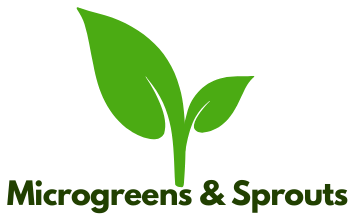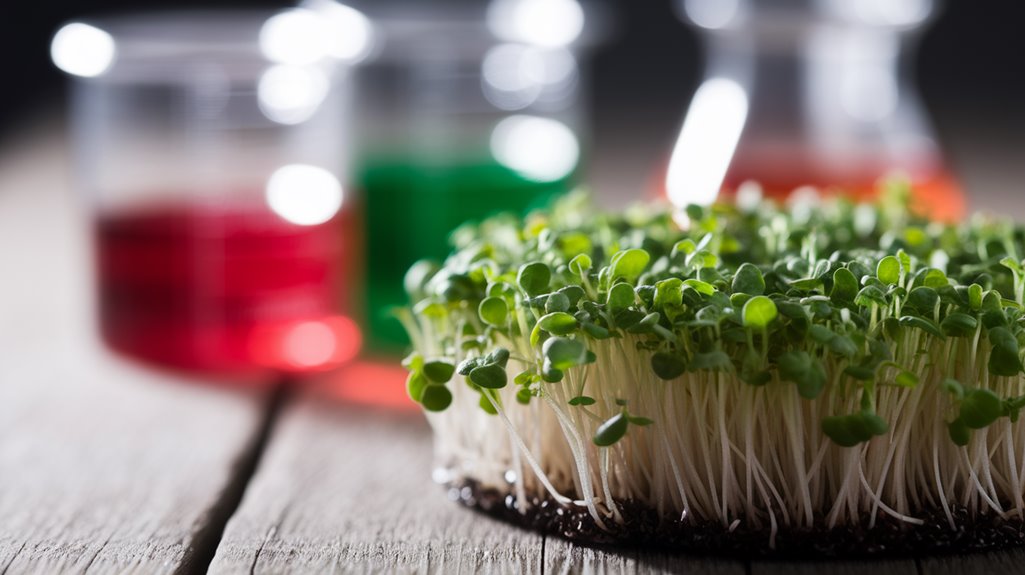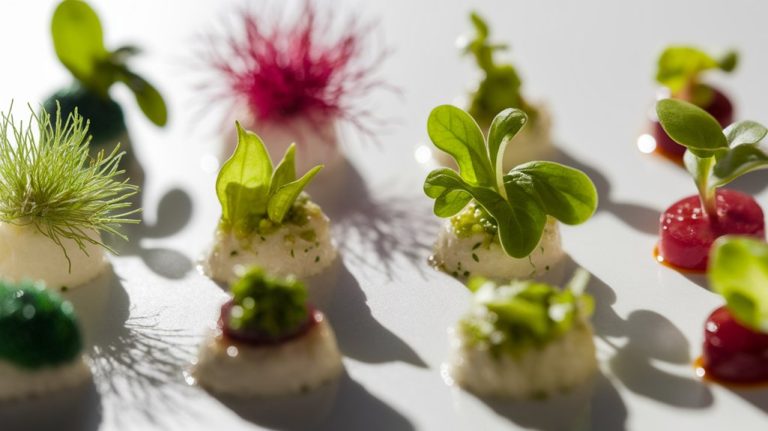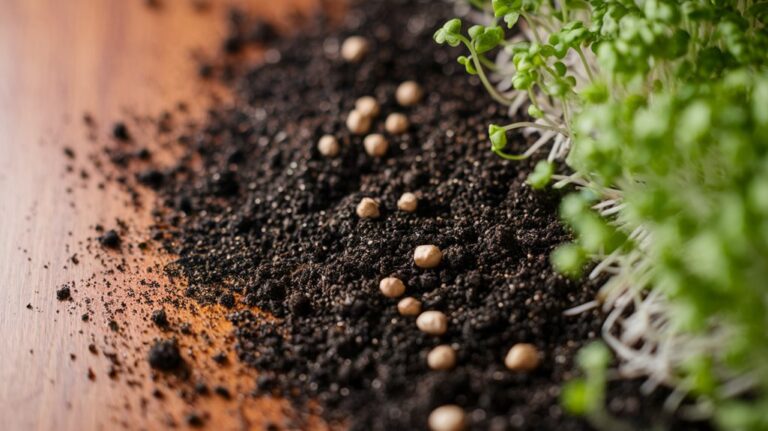The Science Behind the High Antioxidant Levels in Microgreens
Microgreens have impressively high antioxidant levels due to their unique genetic makeup, optimal growth conditions, and efficient photosynthesis. Their genetic traits enhance phytochemical production, especially when grown in nutrient-rich soil and under ample light. These factors promote antioxidant synthesis, enabling microgreens to contain up to 40 times the nutrients of mature plants. By understanding these mechanisms, I can appreciate how microgreens contribute to our health, and I’ll uncover more about specific types and their benefits next.
Key Takeaways
- Microgreens have a high antioxidant content due to specific genes that regulate phytochemical production, surpassing the levels found in mature vegetables.
- Enhanced light exposure during growth significantly boosts photosynthesis, leading to increased production of antioxidants in microgreens.
- Stress adaptation in microgreens stimulates antioxidant levels, creating a synergistic effect that enhances overall nutrient density.
- Harvesting microgreens just before maturity maximizes their nutritional value, including peak antioxidant levels.
- Growing conditions, such as nutrient-rich soil and optimal temperature, play a crucial role in increasing antioxidant content in microgreens.
Understanding Antioxidants: What They Are and Why They Matter
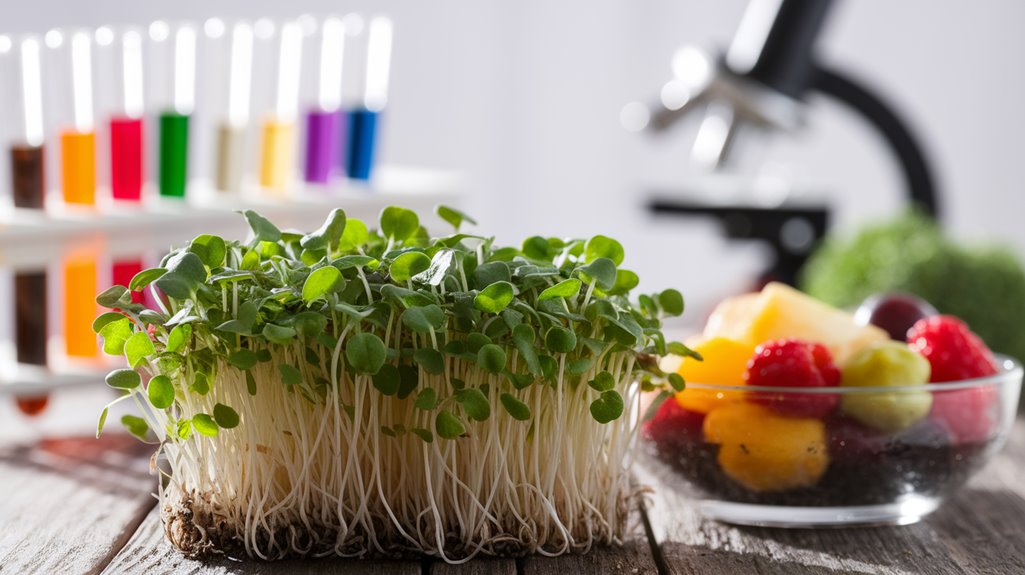
Although we often hear about antioxidants in health discussions, understanding what they truly are and why they matter is crucial for making informed dietary choices.
Antioxidants are compounds that neutralize free radicals—unstable molecules that can cause cellular damage and contribute to chronic diseases. Scientific studies show that a diet rich in antioxidants can reduce inflammation and lower the risk of conditions like heart disease and cancer.
Microgreens, in particular, are noted for their high antioxidant content, often exceeding that of mature vegetables. By incorporating these nutrient-dense plants into our diet, we can enhance our overall health.
It’s essential to recognize the role of antioxidants not just as buzzwords, but as vital elements that support our body’s defenses against oxidative stress.
The Genetic Makeup of Microgreens
While many people appreciate the vibrant flavors and nutritional benefits of microgreens, their genetic makeup plays a critical role in their health-promoting properties. The specific genes in these plants influence their nutrient profiles, particularly antioxidants.
Here’s what I’ve found interesting about their genetics:
- Species Variation: Different species possess distinct antioxidant capacities.
- Gene Expression: Specific genes regulate the production of phytochemicals linked to antioxidants.
- Adaptation: Microgreens often adapt to stressors, enhancing their antioxidant levels through genetic responses.
- Nutritional Synergy: The interplay of various genes can create synergistic effects, boosting overall nutrient density.
Understanding these genetic factors helps illuminate why microgreens are so rich in beneficial compounds, making them a smart choice for health-conscious eaters.
Growth Conditions and Their Impact on Nutrient Density
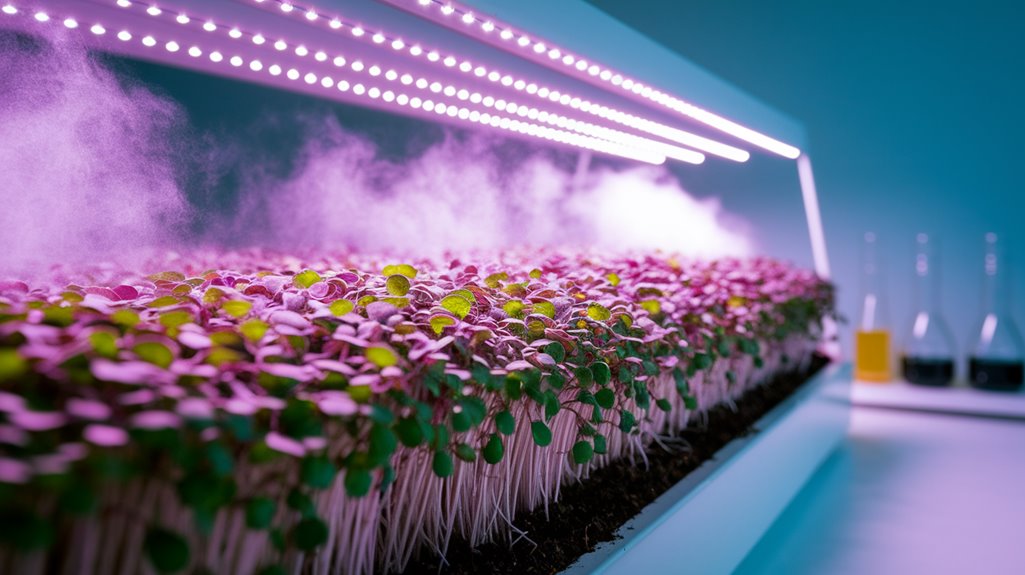
I’ve found that the growth conditions of microgreens, particularly light exposure and soil quality, significantly impact their nutrient density.
Research indicates that optimal light can enhance antioxidant levels, while nutrient-rich soil contributes to overall plant health.
Understanding these factors can help us maximize the benefits of our microgreens.
Light Exposure Effects
Light exposure plays a crucial role in the growth of microgreens, significantly influencing their nutrient density. Through my observations and research, I’ve noticed how varying light conditions can lead to different antioxidant levels.
Here are four key effects of light exposure:
- Photosynthesis Efficiency: Adequate light enhances photosynthesis, boosting essential nutrient production.
- Color Variation: Higher light intensity often results in deeper pigmentation, indicating increased phytochemical content.
- Growth Rate: Optimal light conditions accelerate growth, leading to denser nutrient profiles in a shorter time.
- Stress Response: Limited light can induce a stress response, which may enhance antioxidant levels as a protective mechanism.
Understanding these factors helps me optimize microgreen cultivation for maximum nutritional benefits.
Soil Quality Influences
Soil quality significantly impacts the growth conditions of microgreens, directly influencing their nutrient density.
I’ve observed that nutrient-rich soils, often high in organic matter, promote robust growth and enhance antioxidant levels. Research shows that soils with balanced pH and adequate minerals, such as nitrogen and phosphorus, can lead to microgreens with significantly higher vitamin concentrations.
Conversely, poor soil quality can stunt growth and reduce nutrient uptake, resulting in less potent microgreens. For instance, a study demonstrated that microgreens grown in composted soil had up to 50% more antioxidants than those in depleted soils.
Thus, selecting high-quality soil isn’t just an afterthought; it’s essential for maximizing the health benefits of these tiny powerhouses.
The Role of Photosynthesis in Antioxidant Production
In my exploration of microgreens, I’ve found that photosynthesis plays a crucial role in antioxidant production.
The intensity of light not only influences growth but also affects the levels of these beneficial compounds.
Understanding this relationship can help us optimize conditions for higher antioxidant yields.
Photosynthesis and Antioxidants
While many may overlook the connection between photosynthesis and antioxidant production, understanding this relationship reveals how essential these processes are for plant health and nutrition.
Photosynthesis isn’t just about energy; it directly influences the synthesis of antioxidants in microgreens. Here’s how:
- Chlorophyll Production: The green pigment captures light energy, crucial for initiating photosynthesis.
- Energy Transfer: This energy fuels biochemical reactions that produce antioxidant compounds.
- Reactive Oxygen Species (ROS): During photosynthesis, ROS are generated, prompting plants to produce antioxidants as a defense mechanism.
- Nutrient Uptake: Photosynthesis enhances the uptake of minerals, which are vital for synthesizing various antioxidants.
Light Intensity Effects
Light intensity plays a crucial role in the antioxidant production of microgreens, directly impacting their nutritional value. I’ve observed that higher light exposure can enhance photosynthesis, resulting in increased levels of antioxidants. This relationship is evident when comparing microgreens grown under varying light conditions.
| Light Intensity (µmol/m²/s) | Antioxidant Level (mg/g) | Microgreen Variety |
|---|---|---|
| 100 | 25 | Radish |
| 200 | 35 | Broccoli |
| 300 | 50 | Kale |
| 400 | 60 | Arugula |
| 500 | 70 | Mustard |
As shown, as light intensity increases, so does the antioxidant content. This data underlines the importance of optimizing light conditions for enhancing microgreens’ health benefits.
Comparisons Between Microgreens and Mature Plants
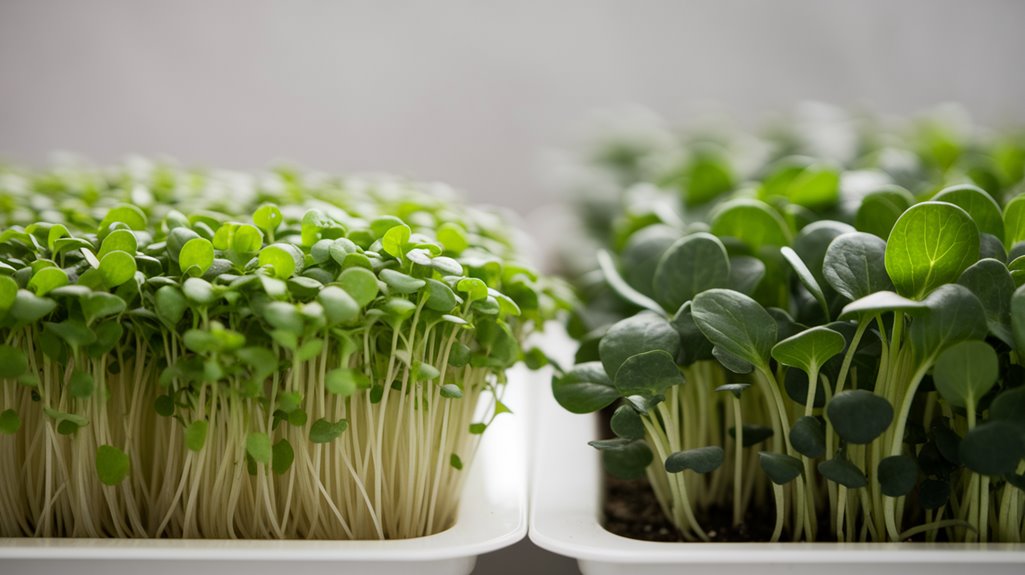
When I compare microgreens to their mature counterparts, it’s clear that these tiny plants pack a surprising nutritional punch. Research shows that microgreens often contain higher concentrations of vitamins, minerals, and antioxidants.
Here are some key differences:
- Nutrient Density: Microgreens can have up to 40 times more nutrients than mature plants.
- Antioxidant Levels: They typically boast higher levels of antioxidants, which combat oxidative stress.
- Flavor Profile: Microgreens are often more flavorful, enhancing culinary experiences.
- Growth Time: They mature in just 7-21 days, making them a quick and sustainable option.
These factors highlight the unique advantages of microgreens, making them a valuable addition to any diet.
Common Types of Microgreens and Their Antioxidant Profiles
Exploring the world of microgreens reveals not only their impressive nutrient density but also the diverse types available, each with distinct antioxidant profiles.
For instance, broccoli microgreens are renowned for their high levels of sulforaphane, a powerful antioxidant linked to cancer prevention. Similarly, red cabbage microgreens boast a high concentration of anthocyanins, which are known for their anti-inflammatory properties.
On the other hand, sunflower microgreens provide a good dose of vitamin E, contributing to overall antioxidant activity. Pea shoots, rich in vitamins A and C, also add to their antioxidant benefits.
Understanding these profiles helps us appreciate how different microgreens can enhance our diets, providing targeted health benefits through their unique antioxidant compounds.
The Impact of Harvesting Time on Nutritional Value
While the timing of microgreens’ harvest may seem like a minor detail, it significantly influences their nutritional value. Research shows that harvesting at the right moment can enhance their antioxidant levels.
Here’s what I’ve observed:
- Optimal Growth Stage: Nutrients peak when microgreens are harvested just before they mature.
- Light Exposure: Extended light exposure during growth can lead to increased antioxidant production.
- Temperature Variations: Cooler growing conditions may enhance certain nutrient profiles.
- Species-Specific Timing: Different microgreens reach their nutritional zenith at varying times; knowing the specifics is crucial.
Tips for Maximizing Antioxidant Benefits From Microgreens
To maximize the antioxidant benefits from microgreens, I recommend focusing on specific growing and storage practices that can significantly enhance their nutrient profile.
First, consider growing microgreens in organic soil, which has been shown to yield higher antioxidant levels compared to hydroponic systems. Additionally, harvesting them just before they reach maturity captures peak nutrient density.
Storage is equally crucial; keep microgreens in a cool, dark place to minimize oxidation. Using airtight containers can further preserve their freshness.
Lastly, incorporating a variety of microgreens into your diet will ensure a broader spectrum of antioxidants. Research indicates diverse phytochemicals work synergistically, amplifying health benefits.
Frequently Asked Questions
Conclusion
In conclusion, the high antioxidant levels found in microgreens stem from their genetic makeup, growth conditions, and photosynthetic processes. By understanding these factors, we can appreciate why microgreens offer superior nutritional benefits compared to their mature counterparts. Moreover, paying attention to harvesting times and selecting specific varieties can further enhance their antioxidant profiles. Incorporating microgreens into our diets is not just a trend; it’s a scientifically backed way to boost our health and well-being.
